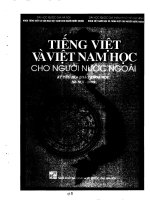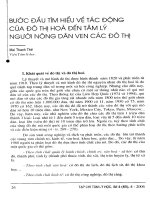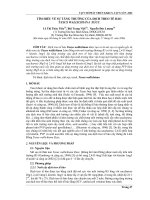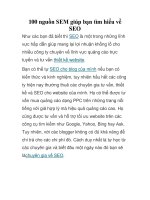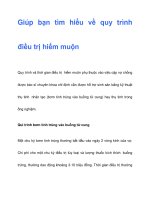marketing từ cơ bản đến nâng cao
Bạn đang xem bản rút gọn của tài liệu. Xem và tải ngay bản đầy đủ của tài liệu tại đây (4.57 MB, 74 trang )
MARKETING
Luu Nhat Huy, MBA, B.Sc.
University of Technology – Vietnam National University
URL: />PART 1: OVERVIEW
1. Definition Marketing
2. Orientations
3. Roles of Marketing
4. Key concepts
Marketing
–
Luu Nhat Huy
2
DEFINING MARKETING
Marketing is a societal process by which
individuals and groups obtain what they need and
want through creating, offering, and freely
exchanging products and services of value with
others.
- Philip Kotler
Philip Kotler & Gary Amstrong, 2007
“The process by which companies create value for
customers and build strong customer relationships in
order to capture value from customers in return”
4
Marketing
–
Luu Nhat Huy
ANOTHER DEFINITION
SIMPLE MARKETING SYSTEM
Industry
(a collection
of sellers)
Market
(a collection
of Buyers)
Goods/services
Money
Communication
Information
Production Concept
Product Concept
Selling Concept
Marketing Concept
Consumers prefer products that are
widely available and inexpensive
Consumers favor products that
offer the most quality, performance,
or innovative features
Consumers will buy products only if
the company aggressively
promotes/sells these products
Focuses on needs/ wants of target
markets & delivering value
better than competitors
COMPANY ORIENTATIONS TOWARDS THE MARKETPLACE
EVOLVING VIEWS OF MARKETING’S ROLE
a. Marketing as an
equal function
Finance
Production
Marketing
Human
resources
b. Marketing as a more
important function
Finance
Human
resources
Marketing
Production
EVOLVING VIEWS OF MARKETING’S ROLE
c. Marketing as the
major function
Marketing
Production
d. The customer as the
controlling factor
Customer
EVOLVING VIEWS OF MARKETING’S ROLE
e. The customer as the controlling
function and marketing as the
integrative function
Customer
Marketing
Production
DETERMINANTS OF CUSTOMER DELIVERED VALUE
Image value
Personnel value
Services value
Product value
Total
customer
value
Monetary cost
Time cost
Energy cost
Psychic cost
Total
customer
cost
Customer
delivered
value
Satisfaction
is a person’s feelings of
pleasure or disappointment resulting from
comparing a product’s perceived
performance (or outcome) in relation to
his or her expectations.
SATISFIED CUSTOMERS:
Are loyal longer
Buy more (new products & upgrades)
Spread favorable word-of-mouth
Are more brand loyal (less price sensitive)
Offer feedback
Reduce transaction costs
THE FOUR PS
Marketing
Mix
Product
Price Promotion
Place
PART 2: EVIRONMENT
MIS AND MKT RESEARCH
1. MKT Environment
2. MIS
3. MR
4. Type of MKT research
Marketing
–
Luu Nhat Huy
14
15
Marketing
–
Luu Nhat Huy
MARKETING ENVIRONMENT
Political factors
Legal and regulations
Social/cutural factors
Technological
factors
Economic
factors
C
Customer
Competitors
Supplier Distributor
MIS
A marketing information system (MIS) consists of
people, equipment, and procedures to gather, sort,
analyze, evaluate, and distribute needed, timely,
and accurate information to marketing decision
makers.
A marketing intelligence system is a set of
procedures and sources used by managers to
obtain everyday information about developments in
the marketing environment.
MIS
17
Marketing
–
Luu Nhat Huy
MI
Internal
Data
MR DSS
Environment
Market
Customer
Channels
Macro factors
…
MKT decision
maker
Strategy
Plan
Implementation
Control
Market research is the process of systematic
gathering, recording and analyzing of data about
customers, competitors and the market.
Market research can help create a business plan,
launch a new product or service, fine tune existing
products and services, expand into new markets etc.
...
18
Marketing
–
Luu Nhat Huy
MARKET RESEARCH
THE MARKETING RESEARCH PROCESS
Defining the
problem and
research
objectives
Developing
the research
plan
Collect the
information
Analyze the
information
Present the
findings
SECONDARY-DATA SOURCES
Internal Sources
Government Publications
Periodicals and Books
Commercial Data
On-Line
Associations
Business Information
RESEARCH APPROACHES
Behavioral
Focus-group
Survey
Experimental
Observational
PART 3: CONSUMER BEHAVIOR
Marketing
–
Luu Nhat Huy
22
CONSUMER BUYING PROCESS
Problem
recognition
Information
search
Evaluation of
alternatives
Purchase
decision
Postpurchase
behavior
24
Marketing
–
Luu Nhat Huy
STIMULI-RESPONSE MODEL
Stimulus Organism Response
MODEL OF BUYING BEHAVIOR
Buyer’s decision
process
Problem recognition
Information search
Evaluation
Decision
Postpurchase
behavior
Other
stimuli
PEST
Buyer’s
characteristics
Cultural
Social
Personal
Psychological
Buyer’s decisions
Product choice
Brand choice
Dealer choice
Purchase timing
Purchase amount
Marketing
stimuli
4P

